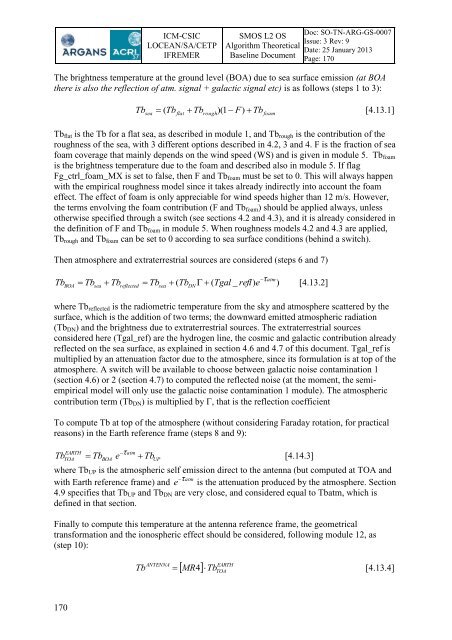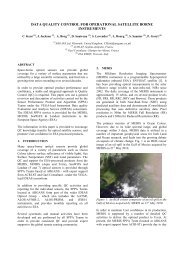SMOS L2 OS ATBD - ARGANS
SMOS L2 OS ATBD - ARGANS
SMOS L2 OS ATBD - ARGANS
You also want an ePaper? Increase the reach of your titles
YUMPU automatically turns print PDFs into web optimized ePapers that Google loves.
170<br />
ICM-CSIC<br />
LOCEAN/SA/CETP<br />
IFREMER<br />
<strong>SM<strong>OS</strong></strong> <strong>L2</strong> <strong>OS</strong><br />
Algorithm Theoretical<br />
Baseline Document<br />
Doc: SO-TN-ARG-GS-0007<br />
Issue: 3 Rev: 9<br />
Date: 25 January 2013<br />
Page: 170<br />
The brightness temperature at the ground level (BOA) due to sea surface emission (at BOA<br />
there is also the reflection of atm. signal + galactic signal etc) is as follows (steps 1 to 3):<br />
Tb ( Tb Tb<br />
)( 1<br />
F)<br />
Tb<br />
[4.13.1]<br />
sea<br />
flat<br />
rough<br />
Tbflat is the Tb for a flat sea, as described in module 1, and Tbrough is the contribution of the<br />
roughness of the sea, with 3 different options described in 4.2, 3 and 4. F is the fraction of sea<br />
foam coverage that mainly depends on the wind speed (WS) and is given in module 5. Tbfoam<br />
is the brightness temperature due to the foam and described also in module 5. If flag<br />
Fg_ctrl_foam_MX is set to false, then F and Tbfoam must be set to 0. This will always happen<br />
with the empirical roughness model since it takes already indirectly into account the foam<br />
effect. The effect of foam is only appreciable for wind speeds higher than 12 m/s. However,<br />
the terms envolving the foam contribution (F and Tbfoam) should be applied always, unless<br />
otherwise specified through a switch (see sections 4.2 and 4.3), and it is already considered in<br />
the definition of F and Tbfoam in module 5. When roughness models 4.2 and 4.3 are applied,<br />
Tbrough and Tbfoam can be set to 0 according to sea surface conditions (behind a switch).<br />
Then atmosphere and extraterrestrial sources are considered (steps 6 and 7)<br />
Tb<br />
BOA<br />
atm<br />
Tb Tb Tb ( Tb ( Tgal _ refl ) e<br />
τ<br />
) [4.13.2]<br />
sea<br />
reflected<br />
sea<br />
DN<br />
where Tbreflected is the radiometric temperature from the sky and atmosphere scattered by the<br />
surface, which is the addition of two terms; the downward emitted atmospheric radiation<br />
(TbDN) and the brightness due to extraterrestrial sources. The extraterrestrial sources<br />
considered here (Tgal_ref) are the hydrogen line, the cosmic and galactic contribution already<br />
reflected on the sea surface, as explained in section 4.6 and 4.7 of this document. Tgal_ref is<br />
multiplied by an attenuation factor due to the atmosphere, since its formulation is at top of the<br />
atmosphere. A switch will be available to choose between galactic noise contamination 1<br />
(section 4.6) or 2 (section 4.7) to computed the reflected noise (at the moment, the semiempirical<br />
model will only use the galactic noise contamination 1 module). The atmospheric<br />
contribution term (TbDN) is multiplied by , that is the reflection coefficient<br />
To compute Tb at top of the atmosphere (without considering Faraday rotation, for practical<br />
reasons) in the Earth reference frame (steps 8 and 9):<br />
EARTH<br />
atm<br />
TbTOA TbBOA<br />
e <br />
τ<br />
Tb<br />
UP<br />
foam<br />
[4.14.3]<br />
where TbUP is the atmospheric self emission direct to the antenna (but computed at TOA and<br />
atm<br />
with Earth reference frame) and e<br />
τ <br />
is the attenuation produced by the atmosphere. Section<br />
4.9 specifies that TbUP and TbDN are very close, and considered equal to Tbatm, which is<br />
defined in that section.<br />
Finally to compute this temperature at the antenna reference frame, the geometrical<br />
transformation and the ionospheric effect should be considered, following module 12, as<br />
(step 10):<br />
EARTH<br />
MR Tb<br />
ANTENNA<br />
Tb <br />
4 [4.13.4]<br />
TOA



